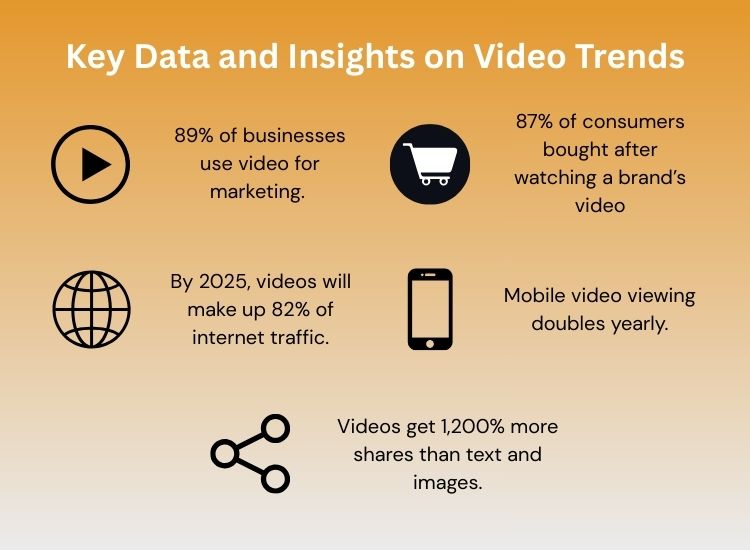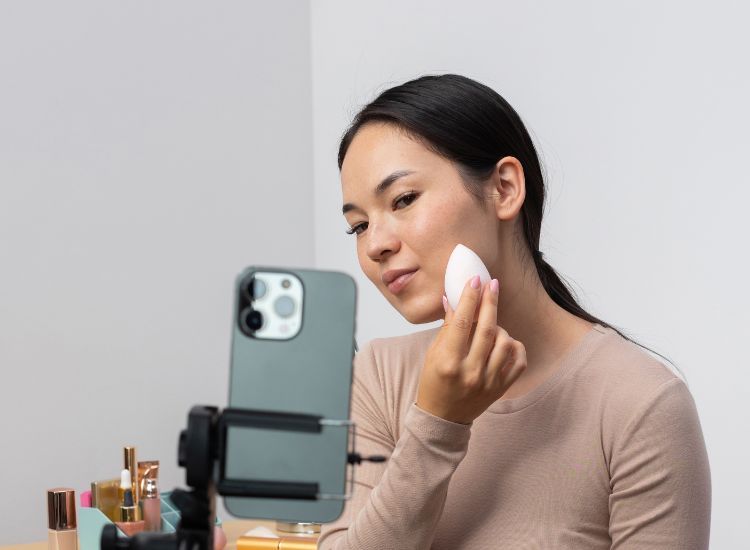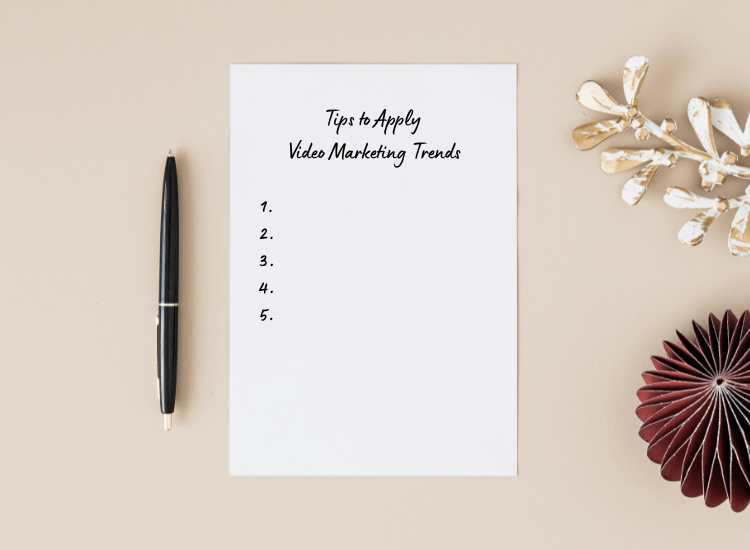



Video marketing is evolving quickly. In 2025, brands are not just competing for attention but for real audience connection. Algorithms now prioritize relevance and authenticity, while viewers expect content that feels personal and meaningful.
From AI-assisted video creation to shoppable and interactive formats, this year’s trends show that success comes from creating smarter, more engaging videos rather than simply producing more of them. In this guide, we’ll look at the key video marketing trends for 2025 and how they can help your brand stay ahead.

Understanding the scale of video adoption helps explain why video marketing trends are critical for businesses in 2025. The numbers highlight how audiences prefer video over other types of content and why marketers are increasing their investment.
These numbers show that video is no longer a secondary channel. It drives awareness, conversions, and long-term brand loyalty. Marketers who align with the latest video content trends position themselves to reach larger audiences and generate stronger results.
Explore our full roundup of video marketing statistics to see how brands are using video to drive engagement and sales, and where you can gain an edge.
Short-form content is one of the strongest video marketing trends driving engagement. Platforms like TikTok, Instagram Reels, and YouTube Shorts keep audiences hooked with quick, impactful storytelling. These clips are easy to consume and share, and they are designed for today’s attention spans.
To stand out, brands should focus on:
A clothing brand, for example, can showcase a new collection through a quick styling tip video, while a software company might use short-form tutorials to highlight product features.

Authenticity remains a priority for consumers, and user-generated content is central to this shift. UGC builds trust because it showcases real people sharing genuine experiences. Reviews, unboxing videos, and branded challenges are among the most effective formats.
Key strategies to use UGC in video marketing include:
For instance, beauty brands often feature tutorials from real users, which resonate far more than polished studio ads. This approach boosts credibility and drives higher engagement compared to purely branded content.
As mobile usage continues to climb, vertical video has become a must-have format in video marketing trends. Platforms like Instagram Stories, Snapchat, and TikTok popularized this style, and audiences now expect brands to deliver mobile-first experiences.
Why it matters:
Practical tip: When designing vertical content, keep text large and centered, use bold visuals, and ensure calls-to-action are visible without forcing users to rotate their screens.

Creating great videos isn’t enough if audiences can’t find them. That’s why video SEO has become one of the most impactful trends in video marketing. Search-optimized video content helps businesses rank in both Google results and within video-first platforms like YouTube.
Key practices for better video SEO:
Example: A software company posting a “how-to” tutorial with a keyword-rich title like How to Optimize Video SEO for Marketing can rank higher in search, bringing in organic traffic long after the video is published.
One of the fastest-growing video advertising trends is the rise of shoppable content. Shoppable videos let viewers purchase products directly within the video itself, creating a seamless path from inspiration to checkout. This trend is especially effective on platforms like Instagram and TikTok, where shopping features are integrated into the user experience.
Why it matters:
Example: A fashion brand can showcase a new collection in a short video, with clickable tags that link directly to each product. This strategy not only boosts sales but also enhances customer experience by keeping everything within one platform.

Artificial intelligence is shaping the future of video marketing by making personalization scalable. Instead of one-size-fits-all campaigns, AI tools can tailor video recommendations, automate editing, and even customize ads based on viewer behavior.
Why it matters:
Example: Streaming platforms and e-commerce brands use AI-driven personalization to recommend videos or products based on past activity. Marketers can apply similar strategies by tailoring video ads to different customer personas, increasing relevance and results.
Augmented reality (AR) and virtual reality (VR) are no longer experimental. They are now influencing mainstream video marketing trends by offering audiences more interactive and immersive experiences. These formats allow consumers to engage with products and brands in ways traditional video cannot.
Why it matters:
Example: A furniture retailer can let customers virtually “place” products in their homes through AR-enhanced video ads, while an event organizer might use VR videos to give viewers a front-row seat to live concerts.
With most social media platforms auto-playing videos without sound, creating content that works silently has become essential. This trend pushes marketers to communicate visually, using text overlays, graphics, and captions to deliver their message effectively.
Why it matters:
Example: A tech company explaining a product feature can use animated text, motion graphics, and bold captions to make the video fully understandable without audio. This way, the message lands even when viewers scroll in silence.
While short clips dominate feeds, long-form video still holds a strong place in video marketing trends. Content like webinars, tutorials, and branded documentaries helps brands build authority and credibility by going deeper into a subject.
Why it matters:
Example: A financial services company could host a 30-minute webinar on smart investing strategies. By offering education rather than a direct sales pitch, they position themselves as a trusted advisor while generating leads.

Live video is one of the fastest-growing trends in social media video marketing, enabling brands to connect with audiences in real time. Live streaming creates genuineness and encourages face-to-face communication during everything from product launches to Q&A sessions.
Why it matters:
Example: A fitness brand could live stream a workout session with a trainer, allowing viewers to ask questions and follow along. This creates community engagement while promoting the brand’s products or services in an organic way.
Social media platforms are rapidly evolving their ad formats, making video the centerpiece of online advertising strategies. In-feed ads, bumper ads, influencer collaborations, and sponsored short-form clips are becoming standard across TikTok, Instagram, Facebook, and YouTube.
Why it matters:
Example: A travel company could run a series of 15-second sponsored clips on TikTok, showing quick destination highlights. By using trending sounds and captions, they reach new audiences while driving traffic to booking pages.
The dominance of smartphones means mobile video is now the default viewing experience. This shift makes optimization for smaller screens and mobile-first design one of the most important video marketing trends.
Why it matters:
Example: A restaurant chain could create snackable mobile videos highlighting daily specials, designed for quick viewing on Instagram Stories. Customers scrolling during lunch breaks are more likely to watch and act on these short, mobile-optimized clips.
Interactive video gives viewers more control over the experience by allowing them to click, choose, or respond within the video itself. This transforms passive watching into active participation, making the content more memorable.
Why it matters:
Example: An education company could produce an interactive explainer video where learners choose different scenarios, guiding them through tailored lessons. This increases retention while making the content feel more personalized.
Analytics are now central to video success. Marketers no longer rely on vanity metrics like views alone. Instead, they use advanced tools to measure watch time, drop-off points, and audience demographics to optimize future content.
Why it matters:
Example: An e-commerce retailer could analyze watch-time data from past product videos to identify which formats lead to higher conversions. They can then double down on similar styles in future campaigns.
The future of video marketing is shifting toward authenticity and values-driven storytelling. Audiences are more likely to support brands that communicate openly and align with causes they care about. At the same time, sustainability in video production is becoming part of the conversation.
Why it matters:
Example: A lifestyle brand might release a behind-the-scenes video showcasing how their products are ethically sourced and produced. This reinforces trust while connecting with values-driven audiences.

Spotting video marketing trends is useful, but applying them effectively delivers real results. Below are practical strategies that turn these insights into action:
AI is a practical solution for video marketers. Automated editing platforms and AI-driven captioning tools can significantly cut production time. Personalized video ads, powered by AI, allow brands to deliver targeted content to different customer segments without manually creating numerous variations.
For example, e-commerce companies can use AI to recommend product videos based on customer browsing behavior, increasing both engagement and conversions.
Since most viewers watch content on smartphones, designing videos for mobile is essential. Vertical and square formats fit screens perfectly, providing a seamless viewing experience. Text overlays and large captions are important because videos often play muted by default.
Marketers should also compress files for quicker loading, as delays can lead to drop-offs. A mobile-first approach helps ensure your message remains effective, regardless of how or where it’s consumed.
One video style won’t suit every marketing goal. Short-form clips on TikTok or Instagram raise awareness and spark quick engagement, while long-form webinars, tutorials, or case studies build credibility and develop deeper relationships. Brands that blend both formats can catch attention at the top of the funnel and nurture leads toward conversion.
For instance, a software company might share a 30-second TikTok to highlight a feature, followed by a 20-minute tutorial on YouTube for users seeking deeper learning.
UGC is one of the most trusted types of video content because it’s genuine and relatable. Encouraging customers to create videos through hashtag challenges, product reviews, or contests gives brands ready-made, organic marketing material. Showcasing UGC in ads or on your website not only builds trust but also creates a sense of community.
A skincare brand, for instance, can highlight user testimonials showing real product results, which resonate more strongly than studio-shot campaigns.
Shoppable videos and interactive features can shorten the buying journey by allowing purchases or decisions directly within the content. Adding clickable links, product tags, or polls keeps viewers engaged and reduces the steps between inspiration and action. Marketers should test these features with smaller campaigns first, measuring conversions and refining calls-to-action.
For example, a retailer might launch a shoppable Instagram Story showcasing their new collection, enabling audiences to buy items instantly.
Visibility remains a challenge in crowded digital spaces. Optimizing videos for search engines enhances their visibility across various platforms. Start with keyword-rich titles, meta descriptions, and tags that match what users search for. Upload transcripts and closed captions to improve accessibility and boost indexability.
Eye-catching thumbnails also enhance click-through rates, and search engines see this as a sign of relevance. Businesses should treat video SEO with the same thoroughness as written content optimization.
Data-driven decisions set successful campaigns apart from wasted resources. Beyond simple metrics like views, marketers should look at watch time, audience retention, drop-off points, and social shares. These insights show what’s effective and what needs change.
By regularly reviewing performance, brands can refine future content and ensure resources are used wisely. For instance, shortening videos or restructuring content could enhance retention if analytics show viewers leaving at the 30-second mark.
Brands that apply proven video marketing tips alongside these trends see stronger engagement and more consistent results.
Video marketing trends in 2025 highlight one clear message: audiences want content that feels authentic, accessible, and tailored to their needs. From short-form clips and shoppable ads to AI-powered personalization and immersive AR experiences, the landscape is rapidly evolving. Brands that adapt quickly will capture attention, strengthen engagement, and see higher returns on their video marketing efforts.
Staying ahead means balancing creativity with strategy. It requires testing new formats, optimizing for search, and listening to the data that shows what resonates most with your audience. The future of video content belongs to marketers who embrace these trends not as passing fads, but as opportunities to connect more meaningfully with viewers.
If you’re ready to put these strategies into practice, explore how Teleprompter.com app can streamline your video creation process and help you produce polished, professional content that stands out.
The top video marketing trends this year include short-form content, user-generated videos, shoppable ads, AI-powered personalization, and interactive formats. These approaches help brands reach audiences where they spend the most time, on mobile and social platforms.
Social media platforms prioritize video in their algorithms, which means brands using video are more likely to get visibility and engagement. Vertical video, live streaming, and influencer collaborations are some of the most effective tactics for video marketing on social media today.
Yes. While short clips drive quick engagement, long-form content like webinars, tutorials, and documentaries builds authority and trust. The most effective strategies mix both formats to reach audiences at different stages of the customer journey.
AI supports faster editing, personalized video ads, and predictive insights about what content will perform best. This trend allows brands to deliver highly relevant experiences without dramatically increasing production time.
Video SEO ensures content gets discovered in search results on Google and YouTube. Optimizing titles, descriptions, captions, and thumbnails helps increase visibility, which directly drives traffic, engagement, and conversions.



